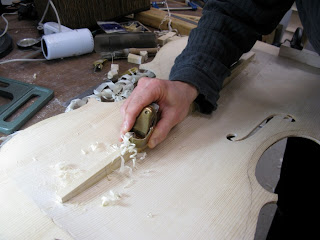
We find it very important to support parts of the cello so as to lengthen its life and minimise the intervention of restorers in decades to come. This takes even more of our time but we respect our instruments to at least that point of giving them as much longevity as we can.
We support the front and back centre joints with little studs of spruce and maple that are then shaped. (This is common practice).
Once the mould has been taken off we also like to line all the inside of the ribs with japanese paper of the finest grade.
This paper, once glued on becomes one with wood. It is so thin that it is almost unseen and cannot be counted as extra weight. However its fibers going across the grain in every direction provide a support as strong as if another piece of wood was here (like plywood).
This will prevent warping, sinking, and cracks on the ribs.
The blocks can then be shaped in order to reduce the weight and it is about that time (before the back is glued on) that we place the label - to insure it is exactly at the right place and well secure (again for decades to come).
This cello now has two labels : one saying the names of the makers, the place it was made and the date; the other one explaining who by and why it was commissioned.
All my labels are made and calligraphed by hand using a quill and japanese ink.
I do not pretend to have amazing calligraphy skills but I like to hang on to that bit of fun that I learned when I was in art school.
 The edge work - rounding around the edges - has been roughly started before the plates were glued to the body so to access easily the underside without damaging the ribs.
The edge work - rounding around the edges - has been roughly started before the plates were glued to the body so to access easily the underside without damaging the ribs.




















